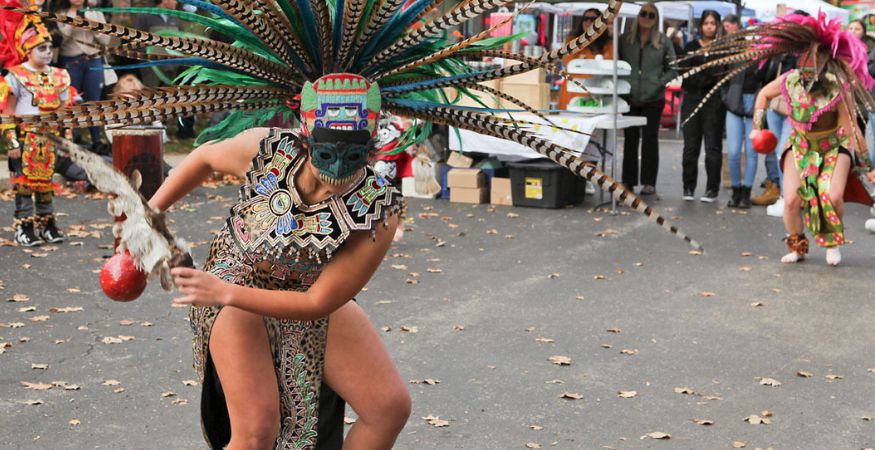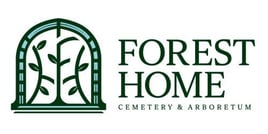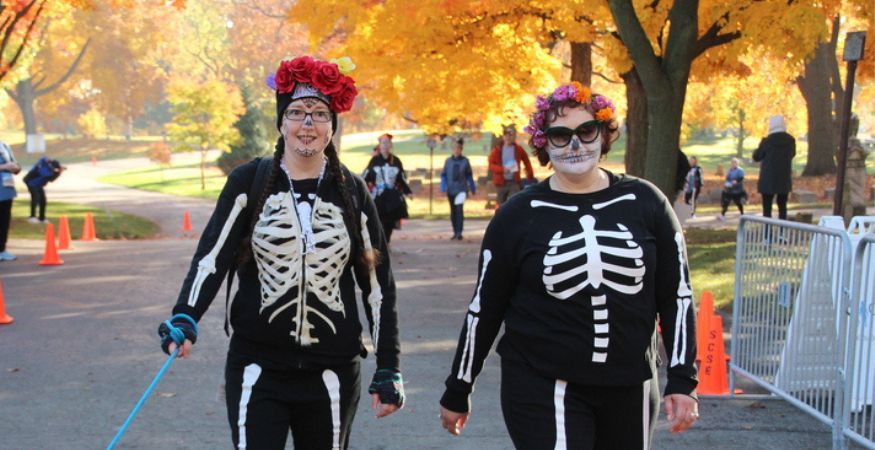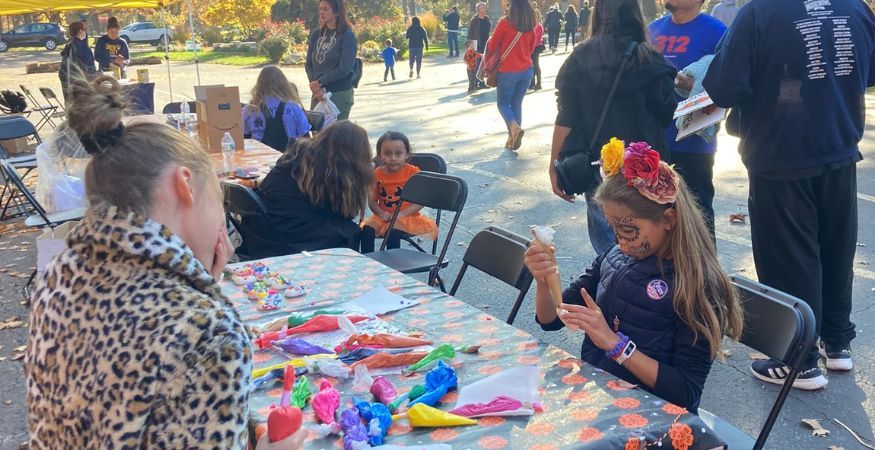Stevenage Embraces Digital Future with PlotBox
Migration, Mapping and Memorial Checks: the benefits of a cloud-based cemetery management system for Stevenage Borough Council.
We learn how Forest Home uses its beautiful urban green space to connect with its community in celebrating life in a myriad of ways.

We're eager to discover more about your cemetery and explore the possibilities of integrating PlotBox seamlessly into your operations.
Let's Talk
We took the opportunity to speak with Jason Seymour, President of Forest Home - an urban green space Cemetery & Arboretum in Milwaukee - about their Day of the Dead festival as just one of the many ways in which they share their space and connect with their community.
I started here in March of 2023 and this is my first role within a deathcare industry organization.
I spent the better part of 20 plus years working in information technology and was brought here to align the team and the operations to a common vision, mission and set of values that the cemetery can use to inform its practices as we move forward.
There are a number of things, and that really speaks to the value of our cherished history.
When we look at that cherished history as a team through our value of human dignity, to us it means that life continues to have value well after it's been lived, and it's our responsibility to maintain that value, to help show that to the community. And to that end, we have launched a number of different programs in the last several years, including our Dia de los Muertos Festival that are about celebrating that life.
On our Memorial Day services here in the United States, we typically have living historians. They're not re-enacting. They're living historians, they dress up, they play the part, but they don't re-enact the person. However, we do have our Spirits of the Silent City event that we just concluded recently - that's an event that has professional actors who are taking on the roles of their particular chosen character in our cemetery.
So there's a number of different ways in which we're bringing the past into life again in the community, and bringing people in to celebrate that.
That can be a difficult task. We have 2,600 trees of over a hundred species. When we were founded, we were located on the outskirts of Milwaukee. Today we are in the urban middle of Milwaukee, which is challenged with green space. And so we're larger than any city park in Milwaukee.
So we’re inviting people in to say, we're not just a place of memorialization - we're here to create a peaceful place for you to enjoy your life.
Yes, we have several active programs. So in addition to all of our cemetery tours that we have, we also offer bird watching tours.
We've also engaged our local municipality. They have a goal of planting several million trees, and we're working with them to meet our goal of planting one thousand trees.
So we’re working with them to refresh our canopy. We have a thousand trees that were planted in 1895, and they're now coming to that point where they're fatiguing.
The plan is to refresh them with another set of trees again for the community that 100 years from now people will be able to continue to appreciate the nature of our campus.
Most recently, we've entered into several different green initiatives with a local partner. For example, they've identified some areas where we can support the environment by keeping fresh rain water from just going right back into the lakes and letting the ground do what it's supposed to do.

Yes, actually, we call it ecological stewardship. The way we've defined that is that celebrating life here at the cemetery extends wherever possible in supporting the world that humanity depends on.
That’s quite a nuanced answer because there are so many different things that the cemetery is doing right now. So we have an event like Dia de los Muertos that is going to be really exciting, and that represents some of the work that we're doing to connect with our local neighborhood.
65% of our local neighborhood is Latino, but there are services [we provide] as an active cemetery that extend socioeconomically into a number of different areas throughout the city and into the suburbs.
Yes, Dia de los Muertos is a highly celebrated event in the Hispanic community. Families come to the graves of their loved ones, building ofrendas [offerings] and altars, doing this as a way to give space for their loved ones to come and be present with them.
The altars are incredibly ornate and they're oftentimes large and vibrant. It’s something that becomes very noticeable, especially in our cemetery.
The festival was borne out of our former Director’s desire to better connect with the community, combined with a motivated community member who had connected with the cemetery. Together they formed a committee and designed a small event. It started out small in 2019 as a march with Aztec dancers to our Guadeloupe section and some grave side ofrendas which had 500 guests attend.
There are several things that rise to the top in terms of what makes it important.
There's a really large community around us that is Hispanic, and so to be able to say to that community that we see them, that they're valuable to our story, and we want their story to be remembered here - that's really, really important.
You know, the conversation that we're having on staff over the last several months has really been about recognizing that cemeteries in general have a really difficult task before them. A lot of society is moving further and further away from [the idea of] how do we handle death?
And so cemeteries are less important in one sense, than they were, say a hundred years ago.
Forest Home is a community-focused nonprofit cemetery, which is unique in our area, and not only that, but the largest in our immediate area.
We see the opportunity to begin the discussion on how cemeteries can reimagine their role in modern society, that we don't have to be a place that only memorializes a loved one, and then everybody can forget about it, [but] we can be a place that does a phenomenal job of celebrating life in a myriad of different ways; whether it's a small family mourning loss of a loved one, or a large community, saying, “Hey, remembering life this way is really important to us.”
And the cemetery is uniquely equipped to do that.
Yes, it’s a volunteer committee, we have several Latino staff that participate on that committee, but the event is primarily run as a volunteer event. We have almost a hundred volunteers this year. There has been so much interest, that we are at the point [of having to turn people away]!
It's really a mix of both traditional and digital marketing methods.
Our Executive Director for the Preservation Association has done a really good job of connecting with various other nonprofits in the community, and that is one area where we're able to go ahead and get the message pushed through the community.
And of those partnerships that we've forged, 15 of them are going to join us at the event with tables and displays.
Social media is another [way we communicate]. And also, direct communication to our families - continuing to share and invite people.
It is a bustling place very early. The staff arrive early to open up the gates and prepare for runners [for the 5k run/walk held on the morning of the event] who arrive early to stretch before the race.
The race is something that initially, had been its own thing, and over time, because of both becoming so popular, they've blended..
The festival itself doesn’t quite [get going in full flow] until around 11 in the morning.
So that first part of the morning it's all business - people are here to run, they're dressed up, they're having fun, and they're doing their part to enjoy the day. Some of the more advanced runners will finish very quickly, and then others will casually make their way through after about an hour and a half.
At which time the food trucks have taken time to arrive, they've come in, and have found their way to their spots. The various vendors we have - around 45 this year -will have made space for their tables in our main area and into our chapel gardens.
The displays for the ofrendas in our chapel will be open for viewing, and then our Victorian Gardens area will become a place where people can gather and celebrate together for things such as face painting and food - they’ll have all of the vendors, and so it will quickly turn into a party.
And then at 3 o’clock everybody says, “Well, we had fun, now let's pack it up!” And so the trucks leave and everybody starts to pack up, and by 4 o’clock we're just a cemetery again.

The event is growing and so we have put in controls to measure that. Last year we had around 2,500 guests and this year, we're expecting probably between 3 and 4,000.
That's incredible numbers, and that creates a parking problem right?
For a campus that has 189 acres, getting them into the cemetery, figuring out where they can park, and then access the event. When you have a run, that's going to use some of the roads and so on.
So there are some really interesting complexities. [To help manage that] we have an army of volunteers - this year we have almost a hundred this year. And how do we equip them with information so that people wanting to understand how to navigate the event can do that effectively?
They get a lot of questions about the cemetery - how do we make sure that they're equipped to share our story in short order?
And all of that together is where a cemetery management software system such as PlotBox can help.
To come at it the other way round, in the first instance, events like this provide an opportunity for a system like PlotBox to grow in its capacity to be helpful. I know that we could be using even more areas within [PlotBox] that could help impact its success - for example, utilizing PlotBox’s digital mapping functionality [to help staff guide visitors and to plan the event]. So that’s something that’s on the radar.
But to be able to pull information from the system and make it actionable - for example, in terms of communicating with families, I think that’s really important.
So, for instance, we have an area of our cemetery called Our Lady of Guadeloupe, and right across from that we have what's called the Garden of Time. Both areas of the cemetery are highly represented as Hispanic areas of the cemetery.
So to be able to pull information out about the families that share life there, and to be able to communicate with them with a piece of mail to say, “Hey, don't forget about the upcoming event”, [that is incredibly useful].
And that’s how I think a solution like PlotBox can really support this type of event.
But perhaps more importantly in terms of what makes these events successful is having a strong team - one that is aligned behind the values of the organization. We couldn’t metabolize the growing pains of creating these events and communicating with families if it wasn’t for them.
And PlotBox can support our team by building tools that will support them.
The feedback has been overwhelmingly positive. Last year we had 20 vendors, and this year we have 45. Every year we know that people want us to [create] more space so that they can be a part of it.
It’s exciting when you can be part of, and experience growth like that.
It could be all of those things, but if we were to look for some immediate operational impact, I think we would miss the real opportunity that exists.
In our view right now cemetery life is about building a strong community - that uniquely and distinctly human experience of bringing life here and making it valuable, even after [death].
If we miss that opportunity as a cemetery by focusing on just the logistics of deathcare, it would be in our eyes a disservice to what we really can offer the community.
We have an opportunity to offer the community something just a little bit more, and so we look at it as a social investment more than anything.
The short-term horizon is to continue to become really exceptional in connecting with the community, while the long term horizon is to figure out large and small ways for people to have a reason to visit us.
Migration, Mapping and Memorial Checks: the benefits of a cloud-based cemetery management system for Stevenage Borough Council.
Discover how PlotBox has been helping Local Councils to transform their bereavement services operations and align their digital strategies.
We learn how the PlotBox Funeral Director Portal has helped Lisburn and Castlereagh City council to provide a more efficient, direct service to...
Be the first to know about our new resources and blogs